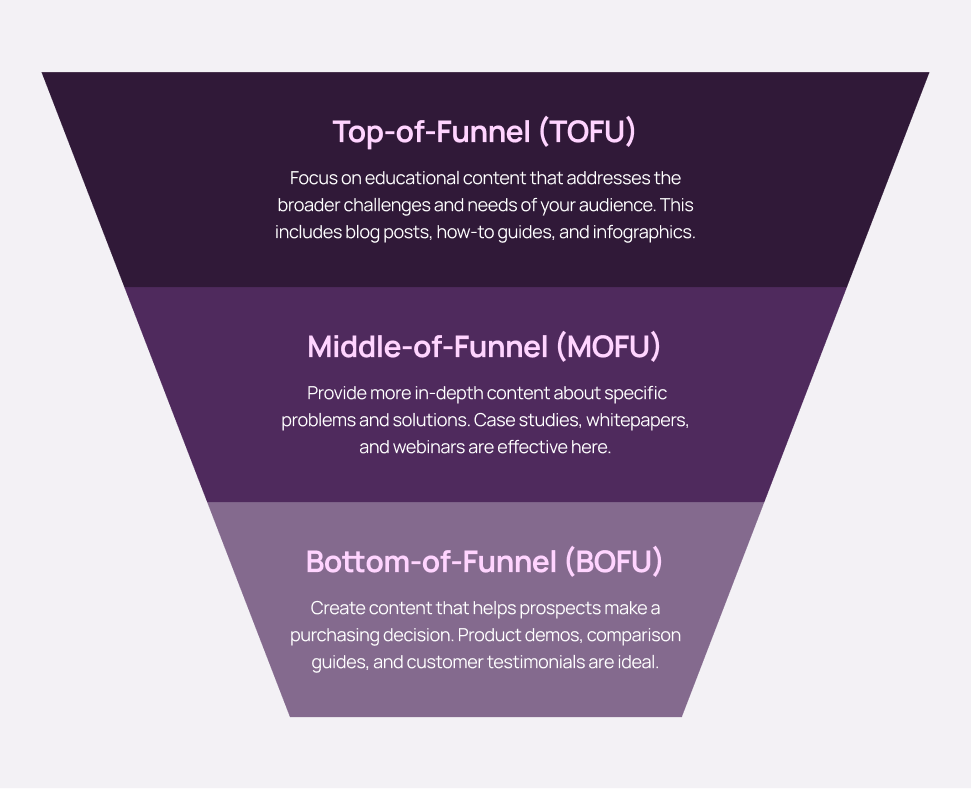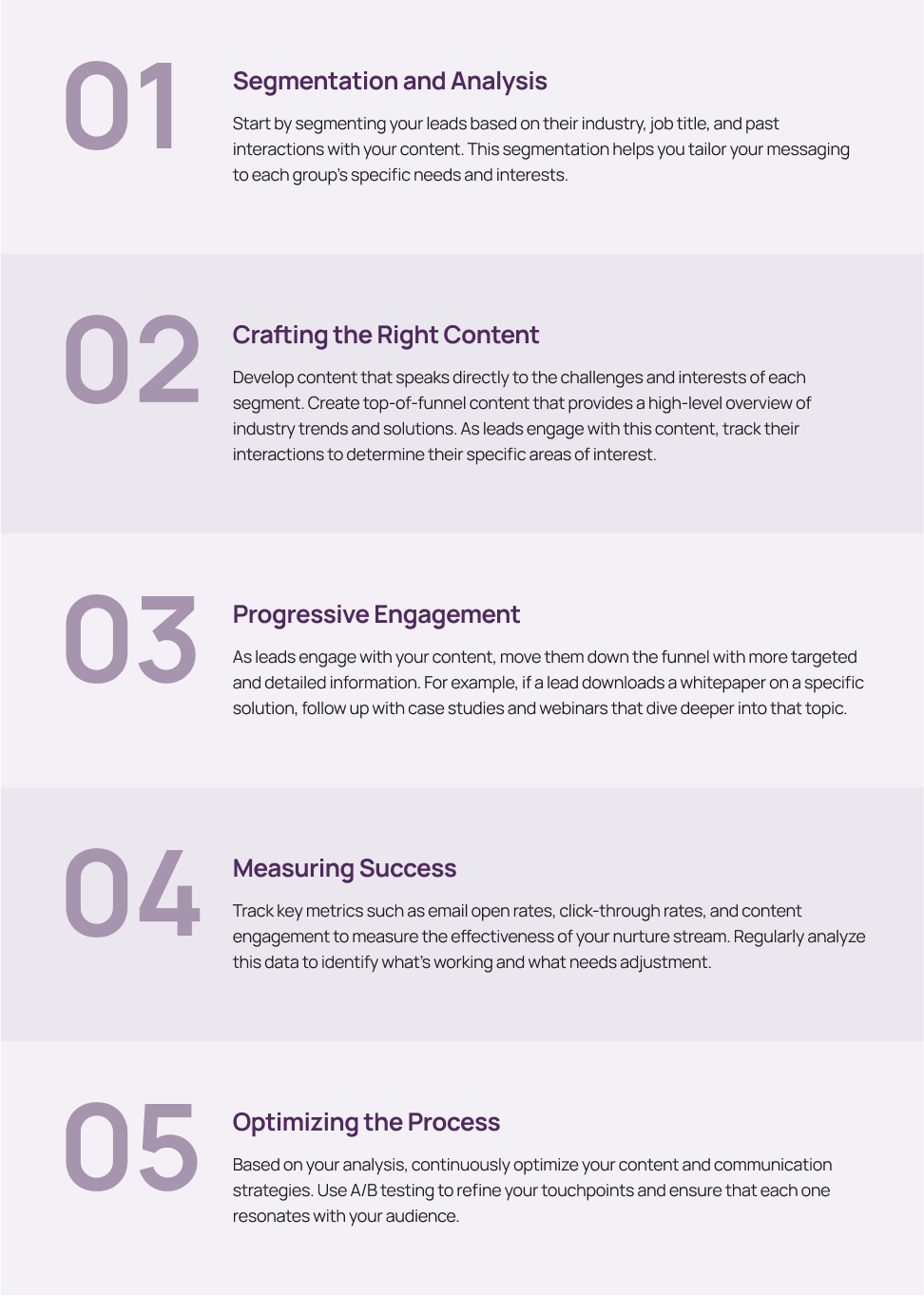Introduction
Nurture streams might just be the game-changer your marketing strategy needs.
Think of nurture streams as a way to build and maintain relationships with your leads through a series of strategic, automated touchpoints, that keep your brand top-of-mind and guide potential customers towards making a purchase.
Why are nurture streams so crucial now? The answer lies in their ability to create personalized experiences at scale. In a market saturated with generic marketing messages, delivering content that speaks directly to people’s needs can set you apart.
Whether you’re looking to optimize your existing approach or starting from scratch, this guide will provide you with the insights you need to create effective nurture programs that drive business growth.
Understanding the Concept: What Are Nurture Streams?
Nurture streams or nurture campaigns are a way to engage your clients through multiple touchpoints across their entire lifecycle. For marketing leaders, it’s not good enough to just bring leads into your system and then drop them. Instead, you need to touch them throughout their journey and keep them engaged.
Lead nurturing means using emails, outreach, and other marketing tools to ensure that your audience aligns with and understands your product and brand.
Nurture streams are essential because they help move people through the funnel. Sending touchpoints to your potential clients helps them engage and shows who is more likely to move along the funnel. Ultimately, what we want is to turn a marketing-qualified lead (MQL) into a sales-qualified lead (SQL).
By analyzing email marketing touchpoints and other key characteristics, you can see who is interested in what product and tailor your marketing campaigns accordingly. This holistic approach ensures clients get touched along their journey without over-communicating but doing enough to keep them intrigued and moving forward.
The Importance of Nurture Streams in Business Growth
Nurture streams are crucial for the growth of your business. You often receive tons of new leads every single day, but identifying which ones are the best prospects can be challenging. While you may have ICP data, like job titles and company names, understanding the intent behind these leads requires a nurture stream.
They also allow you to build lasting relationships with your prospects. By continuously engaging with them, your brand stays top of mind, making it more likely that when they’re ready to make a purchase, they’ll choose your product. This consistent engagement is essential for driving revenue growth and maintaining a competitive edge in the market.
Key Components of Effective Nurture Streams
Creating effective nurture streams requires a blend of several components. Here’s how you can build and optimize your nurture strategy:
Content Strategy
Your content strategy is the backbone of your nurture streams. It’s essential to provide valuable, relevant content that resonates with your audience at the right time. This content can include various types, such as blog posts, whitepapers, case studies, videos, and webinars.
Types of Content

Content Frequency
Consistent communication is key. You need to find the right balance between staying top of mind and not overwhelming your audience. A regular schedule helps maintain engagement without causing fatigue. You also want to ensure your Marketing team have a plan for what piece of content is sent when and by who.
Audience Segmentation
Segmenting your target audience allows you to tailor your messaging and content to the right people, making your nurture streams more effective. Use demographics and behavioral data to create detailed segments.
Demographics
Consider factors like job title, industry, company size, and geographic location to group your audience. This helps ensure that your content is relevant to their specific needs and challenges.
By combining a solid content strategy, detailed audience segmentation, and diverse communication channels, you can create effective nurture streams that engage your prospects and drive business growth.
Real-World Example: Implementing a Successful Nurture Stream
Implementing a successful nurture stream will transform your marketing efforts and drive growth. Here’s a real-world example.
Imagine you have a database filled with leads that haven’t been touched in years. These records represent potential customers who may have expressed interest at some point but have since fallen off the radar. To re-engage these dormant leads, you need a well-structured nurture stream or drip campaign.

Results
By implementing this nurture stream, your team can expect to see a significant increase in engagement and conversion rates. In one example, we were able to move leads from MQL to SQLs at a 25% higher rate than before.
With a clear plan and continuous optimization, you’ll be able to keep your pipeline full of potential customers ready to convert.
Measuring Success: How to Track and Optimize Your Nurture Streams
Measuring the success of your nurture streams is crucial to ensure they’re delivering the desired results. Here’s how to track and optimize them for continuous improvement.
Tracking KPIs
To understand how well your nurture streams are performing, you need to track key metrics. Here are some KPIs to focus on:

Building Reports and Dashboards
Regular reporting is essential to monitor the performance of your nurture streams. Build weekly and monthly reports to keep track of your KPIs. Create dashboards that provide a visual representation of your data to make it easier to identify trends and areas for improvement.
Analyzing Data and Making Adjustments
Regularly analyze the data from your reports and dashboards. Look for patterns and insights that can help you understand what’s working and what’s not. Based on your analysis, make adjustments to your nurture streams. This could involve tweaking your content, changing your communication frequency, or trying new channels.
Leveraging Automation Tools
Use marketing automation tools to streamline your tracking and optimization efforts.

Regular Review and Iteration
Finally, make sure to regularly review your nurture streams. Schedule quarterly reviews to assess the overall performance and make strategic adjustments. Continuously iterate on your strategies to keep your nurture streams effective and aligned with your business goals.
By diligently tracking your KPIs and using automation tools, you can optimize your nurture streams for maximum effectiveness. This ongoing process of measurement and optimization will help you nurture leads more effectively and drive sustained business growth.
Best Practices for Building and Maintaining Nurture Streams
To maximize the effectiveness of your nurture streams, you need to follow best practices that ensure continuous engagement and successful lead conversion. Here are key strategies for building and maintaining effective nurture streams.
Personalization and Segmentation
Personalization is crucial in nurture streams. You should tailor your content to the specific needs and interests of each segment of your audience. By segmenting your leads based on demographics, behavior, and engagement, you can deliver more relevant and impactful messages that increase the likelihood of conversion.
Consistent Communication
Maintaining consistent communication with your leads is essential. You should establish a regular cadence for your nurture streams, whether it’s weekly, bi-weekly, or monthly. Consistency helps to keep your brand top of mind and builds a relationship with your leads. However, be mindful not to overwhelm them with too much communication, which can lead to disengagement.
Automation and Tools
Automation is a key component of successful nurture streams. Utilize marketing automation tools to streamline your efforts and ensure timely delivery of content. Automation allows you to set up workflows that trigger specific actions based on lead behavior, making your nurture streams more efficient and effective.
A/B Testing and Optimization
Regularly test and optimize your nurture streams to improve their performance. A/B testing allows you to compare different versions of your content and identify what resonates best with your audience. Use metrics such as open rates, click-through rates, and conversion rates to measure the effectiveness of your nurture streams and make data-driven adjustments.
Monitoring and Measuring Success
Consistently monitor the performance of your nurture streams to ensure they are meeting your goals. Key Performance Indicators (KPIs) such as lead conversion rates, engagement metrics, and ROI should be tracked and analyzed. By regularly reviewing these metrics, you can identify areas for improvement and optimize your nurture streams for better results.
By following these best practices, you can build and maintain effective nurture streams that drive engagement, build relationships, and ultimately, increase conversions. These strategies will help you stay ahead in the competitive B2B SaaS and Tech marketing landscape.
Collaboration Between Marketing and Sales
A successful nurture stream strategy requires seamless collaboration between marketing and sales. By aligning these two departments, you can ensure that your leads are nurtured effectively and transitioned smoothly from marketing-qualified to sales-qualified leads. Here’s how you can foster a unified approach between marketing and sales:
Shared Goals and Objectives
To create a cohesive nurture stream strategy, start by establishing shared goals and objectives between your marketing and sales teams. Both departments should work towards the same end goal: converting leads into customers.
Open Communication Channels
Encourage your sales team to share insights, feedback, and data about lead behavior and campaign performance. This collaborative approach enables you to refine your nurture strategies based on real-time feedback and results.
Integrated Systems and Tools
Integrate your marketing automation platform with your CRM to provide a seamless flow of information between marketing and sales. This integration allows both teams to access the same data, track lead progress, and view engagement history.
By unifying your marketing and sales efforts, you can create a more effective and efficient nurture stream strategy. Collaboration between these two departments ensures that leads are nurtured with relevant content, transitioned smoothly through the sales funnel, and ultimately converted into loyal customers.
Wrapping up
In 2024, nurture streams will continue to be a cornerstone of an effective marketing strategy. Use them to create meaningful connections with your leads and guide them through their buyer’s journey. And always remember to:
- Stay Personalized: Tailor your content to meet the specific needs and behaviors of your audience. Personalized experiences lead to higher engagement and conversion rates
- Leverage Technology: Utilize the latest automation tools to streamline your processes
- Collaborate Across Teams: Ensure your marketing and sales teams are aligned and working together to provide a seamless experience for your leads
- Measure and Optimize: Continuously monitor the performance of your nurture streams and make data-driven decisions to improve their effectiveness
By following these recommendations, you’ll create powerful nurture streams that build lasting relationships with your leads and drive significant business growth. Embrace the art of nurture streams and watch your marketing efforts flourish in 2024.
-
 Director of Revenue Operations
Kristina Brown
Director of Revenue Operations
Kristina Brown
Did you enjoy this article?
Share it with someone!
